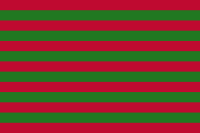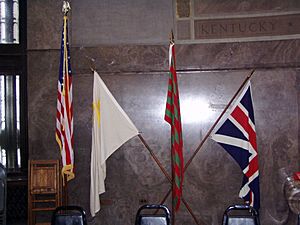George Rogers Clark Flag facts for kids
 |
|
| Use | |
|---|---|
| Design | 13 alternating red and green stripes |
| Designed by | François Riday Busseron |
The George Rogers Clark Flag is a special flag with red and green stripes. It looks a bit like the American Flag. This flag is often connected to a famous American soldier named George Rogers Clark. However, he probably didn't use this exact flag during his battles.
This "Clark" flag was made in a town called Vincennes, Indiana. It likely flew over Fort Sackville even before Clark arrived there.
How the Flag Started
On November 12, 1778, a person from Vincennes named François Bosseron wrote down some interesting details. He recorded buying items for a company flag.
- Paid to St. Marie for 5 ells of red serge for the company flag at 9 livres; 45 livres
- Paid to M. Dajenett for 33⁄4 ells of green serge at 10 livres; 37 Livres 10
- Paid to Madame Godare for the making of the flag; 25 Livres
This flag was designed by Captain Leonard Helm. He was in charge of Fort Sackville. But he had to give up the fort to Lieutenant Governor Henry Hamilton.
Historians aren't completely sure what the flag looked like. But most early American flags had "stripes of rebellion." Captain Helm's design was clear. Hamilton saw two of these flags when he came to Vincennes. One was on a boat, and another was on the fort.
It's possible one of these was Bosseron's flag. Another person, Father Pierre Gibault, might have brought a flag too. Captain Helm had also brought a United States flag to another place called Ouiatenon. So, he might have brought one to Vincennes as well. When Hamilton took the fort, he let Helm take down "the continental flag." Then, the British flag was raised.

Why Red and Green?
The choice of red and green stripes instead of red and white is a bit of a mystery. Maybe there wasn't enough white fabric available in Vincennes at that time.
It's interesting to note that George Rogers Clark offered red and white belts to Native American tribes in Cahokia. These belts meant war or peace. But Captain Helm gave the Wabash Native Americans red or green belts. Later, a Piankeshaw chief gave Lieutenant Governor Hamilton red and green wampum. This was said to represent the Wabash River.
Stripes were a common feature on British American flags even before the American Revolution. Many military flags used by Americans had different colored stripes. Records show flags similar to this one in the 13 colonies. It's possible that Bosseron ordered this flag for his own local army unit in Vincennes. They had decided to support the United States.
George Rogers Clark's Connection
We don't know for sure which flag George Rogers Clark's soldiers marched with. In his own writings, Clark said he had 10 or 12 sets of flags when they took Vincennes. Some people think he might have used the flag of Virginia, his home state.
However, Lieutenant Governor Henry Hamilton wrote about several "American" flags in his journal. He saw them as he traveled down the Wabash River. This included a "rebel flag" he got at Ouiatenon on December 4. When Clark arrived in Vincennes on February 23, 1779, he used many flags. This was to make his army look much bigger than it was. Clark's officer, Captain Bowman, wrote in his journal that an "American flag" was raised over Fort Sackville on February 25, 1778. But he didn't describe what it looked like.

Out of all the flags that might have been used during Clark's Illinois campaign, the 13-striped, red and green flag is the only one with historical records. It was also one of the first "American Flags" flown in what is now the state of Indiana.
This flag pattern has even been used by Indiana National Guard units. They flew it when they were sent to places like Iraq and Afghanistan. Even though George Rogers Clark himself probably never used this specific flag, it carries his name. Flag stores sell it as a "George Rogers Clark flag." It is often flown at events in Indiana and Illinois. It helps people remember Clark's important history in those states. A red and green flag still flies at the George Rogers Clark National Historical Park. It also flies at the Historic Locust Grove plantation near Louisville, Kentucky, where George Rogers Clark passed away.

